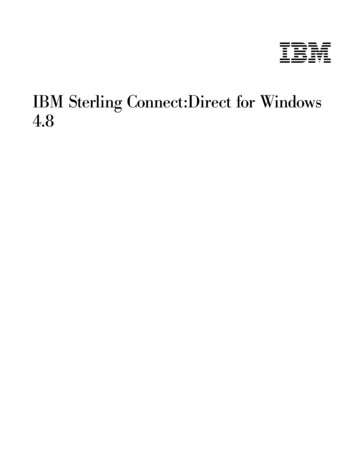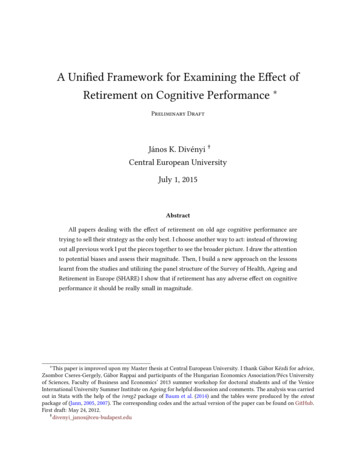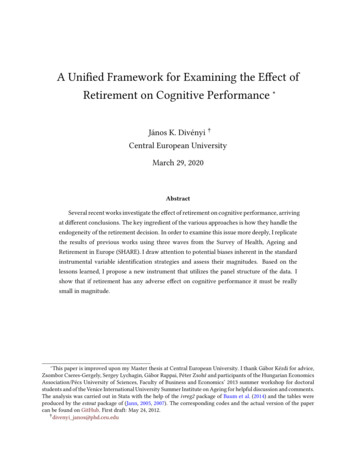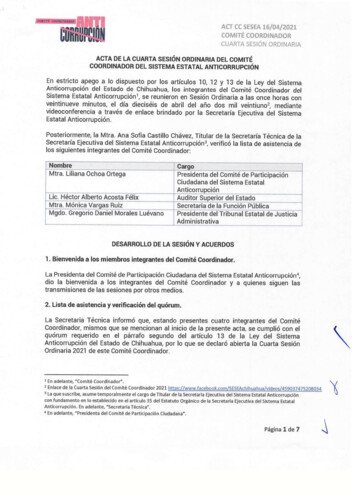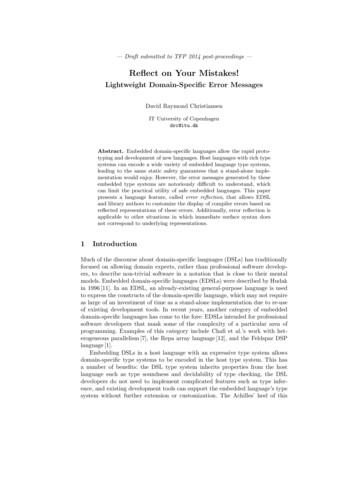
Transcription
— Draft submitted to TFP 2014 post-proceedings —Reflect on Your Mistakes!Lightweight Domain-Specific Error MessagesDavid Raymond ChristiansenIT University of Copenhagendrc@itu.dkAbstract. Embedded domain-specific languages allow the rapid prototyping and development of new languages. Host languages with rich typesystems can encode a wide variety of embedded language type systems,leading to the same static safety guarantees that a stand-alone implementation would enjoy. However, the error messages generated by theseembedded type systems are notoriously difficult to understand, whichcan limit the practical utility of safe embedded languages. This paperpresents a language feature, called error reflection, that allows EDSLand library authors to customize the display of compiler errors based onreflected representations of these errors. Additionally, error reflection isapplicable to other situations in which immediate surface syntax doesnot correspond to underlying representations.1IntroductionMuch of the discourse about domain-specific languages (DSLs) has traditionallyfocused on allowing domain experts, rather than professional software developers, to describe non-trivial software in a notation that is close to their mentalmodels. Embedded domain-specific languages (EDSLs) were described by Hudakin 1996 [11]. In an EDSL, an already-existing general-purpose language is usedto express the constructs of the domain-specific language, which may not requireas large of an investment of time as a stand-alone implementation due to re-useof existing development tools. In recent years, another category of embeddeddomain-specific languages has come to the fore: EDSLs intended for professionalsoftware developers that mask some of the complexity of a particular area ofprogramming. Examples of this category include Chafi et al.’s work with heterogeneous parallelism [7], the Repa array language [12], and the Feldspar DSPlanguage [1].Embedding DSLs in a host language with an expressive type system allowsdomain-specific type systems to be encoded in the host type system. This hasa number of benefits: the DSL type system inherits properties from the hostlanguage such as type soundness and decidability of type checking, the DSLdevelopers do not need to implement complicated features such as type inference, and existing development tools can support the embedded language’s typesystem without further extension or customization. The Achilles’ heel of this
approach is the convoluted error messages that can result from non-trivial encodings: they may bear little resemblance to the embedded surface syntax andthey may be long and stereotypical. The utility of a type error that no user canunderstand is questionable at best.Idris [3] is a dependently typed functional programming language that is expressly built to be a good host for embedded languages. Examples of non-trivialembedded languages include Brady’s algebraic effects language [4] and his earlier language for resource-safe programming [5]. Full dependent types, where thetype system includes the full computational power of the total fragment of theterm language, have the potential to be a host for very expressive embeddedtype systems. Additionally, embedded languages have the potential to hide thecomplexity of full dependent types, allowing programmers to write code as ifthey were working in a simpler language. If this goal is to be practical, then theproblem of error messages must be solved.An embedded query language for relational databases might require thatprojections from tuples select columns that actually exist in the schema. Themechanism described in this paper can transform this generic error message:Can’t solve goalHasCol [("name", STRING), ("age", INT)] "naime" STRINGinto this domain-specific error message:The schema [("name", STRING), ("age", INT)] does not contain thecolumn "naime" with type STRINGContributionsThe primary contribution of this paper is a novel extension to the Idris language,called error reflection, that expands the scope of the reflection mechanism usedfor proof automation to encompass error reporting. Error reflection enables developers to rewrite the compile-time error messages that result from complexAPIs, particularly embedded domain-specific languages, so that the error messages can be consistent with the ideas and metaphors of the API or DSL. Thepaper presents several examples of error messages that can be improved usingerror reflection. Though the technique is implemented in Idris, there is reason tobelieve that it would be applicable to languages without dependent types. Errorreflection is implemented in versions of Idris numbered 0.9.13 and higher.22.1BackgroundReflection in IdrisIdris’s reflection mechanism is closely related to that of Agda [22]. The reflectionmechanism defines a datatype that represents expressions, along with a meansfor quoting, or reflecting, expressions to this datatype and, conversely, a means
of reifying these representations to real expressions. This allows the languageitself to be used to automate the construction of proofs.As described by Brady [3], the Idris compiler contains two programminglanguages: a high-level user-friendly functional language and a low-level fullyexplicit core language that is easy for the machine to type check. A process calledelaboration explains the features of the high-level language, such as type classes,implicit arguments, and where-blocks, in terms of the simple core language.Idris’s reflection datatype faithfully represents the expressions of this corelanguage. The original use for reflection was the implementation of custom prooftactics, represented as functions from reflected representations of a proof contextand goal to a tactic script that solves this goal. Reflection has not yet seenmajor use as a means of compile-time code generation in the style of TemplateHaskell [18].2.2Idris QuasiquotationReflected terms faithfully represent Idris’s highly explicit core theory, and aretherefore somewhat awkward to destructure and construct. An experimental extension to Idris supports the use of quasiquotations for manipulating reflectedterms. Quasiquotations, which syntactically consist of parenthesized Idris termspreceded by a back-tick, represent the reflected version of the term in the quotation. Antiquotations, which are subterms preceded by a tilde,1 cause the antiquoted reflected term to be spliced in to the surrounding quotation. Whenpattern matching, antiquotations instead contain other patterns, which can beeither pattern variables or patterns that match reflected terms.A proof script tactic similar to Coq’s reflexivity, which attempts to solvethe current goal with the constructor of the equality type, can be implementedusing quasiquotation patterns as follows:reflexivity : List (TTName, Binder TT) - TT - Tacticreflexivity ‘( x y) Refine "refl"reflexivity Search 0The tactic checks whether the goal is an equality type, and if so, applies theconstructor. In other cases, it performs a zero-depth proof search, i.e., nothing.This notion of quasiquotation is closer to those found in the Lisp family [2]and Scala [17] rather than to those found in Camlp4 [16] and Haskell [13], becauseIdris quasiquotations are used primarily for manipulating Idris code rather thanfor embedding custom notations. Idris quasiquotations will be described in detailin a forthcoming publication. Quasiquotations are not yet available in a releasedversion of Idris, but they will be in the release following version 0.9.13.1.2.3Techniques for Embedding LanguagesShallow embeddings of DSLs directly use the features of the host language wherethey coincide with the embedded language. For example, addition in the embed1The specific syntax is inspired by the Clojure dialect of Lisp [10].
ded language might directly correspond to addition in the host language, andthe variable binding mechanisms of the host language can implement binders inthe embedded language (a technique known as higher-order abstract syntax, orHOAS [15]). Shallow embeddings can often provide very convenient interfaces,but they have important drawbacks: there is no direct representation of the language’s syntax for later processing, and typical representations of HOAS lead todatatypes that are not strictly positive, rendering them unfit for use in dependently typed languages.A deep embedding uses an ordinary datatype to represent the abstract syntaxof the embedded language. Indexed families, as found in post-GADT Haskell andOCaml as well as in dependently typed languages, allow this approach to encodeexpressive typing rules. Additionally, Idris has feature called DSL notation [5]that allows the direct reification of Idris’s binding syntax to de Bruijn-indexeddatatype families with any inferrable collection of indices, which removes muchof the syntactic advantage of shallow embeddings. However, even though indexedfamilies and DSL notation provide an expressive framework for describing embedded DSLs in a safe and convenient manner, not every feature of an embeddedlanguage is necessarily convenient to represent in this notation.Many embedded languages do not fit the general framework of a functionalprogramming language’s type system. Quite often, an embedded language willhave “side conditions” — invariants on code that should be statically checked.Examples might include ensuring that a variable name is found in some contextor that all elements of one list are contained in another. There are various meansof encoding these constraints, such as Haskell’s type classes and Scala’s implicitarguments. In Idris, a commonly-used technique is to define a type whose inhabitants witness the side condition in question, and then arrange for the compiler toautomatically construct these witnesses when possible. In the interest of simplicity, this paper does not use the more advanced methods of language embedding.However, improving error messages that result from checking side conditions isan important success criterion for the language feature presented in this paper.33.1Error ReflectionMotivating ExampleAs a very simple motivating example, consider a tiny fragment of a database interface library that contains schemas, tuples, and relations, along with Cartesianproducts of relations and projection of individual elements from tuples. Following Oury and Swierstra [14], we define a simple universe of datatypes that willbe supported in the database. For the sake of simplicity, the embedded languagewill support only integers and strings:data Ty INT STRINGinterpTy : Ty - TypeinterpTy INT IntinterpTy STRING String
Schemas are simply lists of pairs of column names and codes from the universe:Schema : TypeSchema List (String, Ty)Tuples are represented by the family Row, which is indexed by schemas:data Row : Schema - Type whereNil : Row [](::) : interpTy t - Row s - Row ((c,t) :: s)In Idris, naming the constructors Nil and (::) allows list literal syntax to beused to construct a Row. The following listing puts these pieces together, showinga concrete schema and row:r : Row [("name", STRING), ("age", INT)]r ["Jane", 43]Projections from a tuple are slightly more complicated: the type of the resultdepends on the schema, and the system should disallow projections of columnsthat do not exist in the schema. Preferably, this check will occur statically. Aconvenient way to achieve this is to define a type of witnesses that a particularattribute is present in a schema, and then arrange for Idris to construct thesewitnesses on demand. The type HasCol s c t represents that schema s containsa column named c with type t, using the standard technique.data HasCol : Schema - String - Ty - Type whereHere : HasCol ((c, t) :: s) c tThere : HasCol s c t - HasCol ((c’,t’)::s) c tProjection can now be defined by recursion over the structure of these witnesses:project : (c : String) - (t : Ty) - (r : Row s) - (ok : HasCol s c t) - interpTy tproject c t []ok FalseElim (emptyNoCols ok)project c t (x :: xs) Here xproject c t (x :: xs) (There p) project c t xs pIn practice, however, we cannot expect users of our embedded query languageto construct a HasCol every time they want to project an element from a tuple.Thus, we redefine ok to be an implicit argument that should be inferred by thecompiler. The auto keyword causes Idris to construct the HasCol witness usingits built-in proof search.project : (c : String) - (t : Ty) - (r : Row s) - {auto ok : HasCol s c t} - interpTy tproject c t []{ok ok} FalseElim (emptyNoCols ok)project c t (x :: xs) {ok Here} xproject c t (x :: xs) {ok There p} project c t xs {ok p}
A relation is a collection of tuples with the same schema. Here, a relation containing n tuples with schema s is represented by a Vect n (Row s). Like SQLand unlike the relational algebra, this encoding allows for duplicate tuples. TheCartesian product, written here with the (*) operator, is the concatenation ofeach row from one relation with each row from another. Just like projection, theCartesian product has a side condition: it is only defined for tuples whose collection of attribute names are disjoint. As before, we represent this side conditionusing an automatically-solved implicit proof of disjointness.(*) : Vect n (Row s1) - Vect m (Row s2) - {auto prf : Disjoint s1 s2} - Vect (n * m) (Row (s1 s2))(*) []ys [](*) (r::rs) ys {prf prf} map (r ) ys ((*) rs ys {prf prf})Ideally, users of an embedded database language would be able to work entirely within the abstractions of the database language, rather than needing toworry about the details of proof automation and implicit arguments. However,when they make mistakes, the error messages are expressed in terms of the underlying implementation of the static semantics. The purpose of this work is toimprove on this situation.3.2Error MessagesThe relation humans describes people and their ages, while housing lists the sizeof two apartments:humans : Vect 2 (Row [("name", STRING), ("age", INT)])humans [ ["Alice", 37], ["Bob", 23]]housing : Vect 2 (Row [("floorspace", INT)])housing [[48], [72]]The first column of the first row in humans can be extracted using project,but if a user misspells a column name, then the resulting error message can bedifficult to decode: project "name" STRING (head humans)"Alice" : String project "naime" STRING (head humans)Can’t solve goalHasCol [("name", STRING), ("age", INT)] "naime" STRINGLikewise, the Cartesian product of humans and housing contains the expectedfour tuples. However, trying to take the product of humans and itself resultsin an error that reflects details of the DSL implementation rather than domainconcepts:
humans * housing[["Alice", 37, 48],["Alice", 37, 72],["Bob", 23, 48],["Bob", 23, 72]] : Vect 4(Row [("name", STRING),("age", INT),("floorspace", INT)]) humans * humansCan’t solve goalDisjoint [("name", STRING), ("age", INT)][("name", STRING), ("age", INT)]Careful naming of the required proof objects can sometimes lead to these errors being somewhat understandable, as above. However, good error messagesshould do more than simply provide a vague hint about why a problem arose.They should explain the problem, and do so in an accessible and straightforwardmanner.3.3Reflecting ErrorsIn recent versions of Idris, the compiler is capable of reflecting its error messages.The standard library contains a datatype corresponding to the compiler’s owninternal representation of errors, and Idris functions can insert themselves intothe error reporting mechanism to rewrite errors before they are shown to users.In some sense, these error handlers resemble exception handlers, except they canonly raise a new exception, rather than recovering from the error and continuingthe program.An error handler is a partial function from a representation Err of errormessages to a rewritten error report. Accordingly, we might assign them thetype Err - Maybe String. However, error messages have more structur
of the embedded language. Indexed families, as found in post-GADT Haskell and OCaml as well as in dependently typed languages, allow this approach to encode expressive typing rules. Additionally, Idris has feature called DSL notation [5] that allows the direct rei cation of Idris's binding syntax to de Bruijn-indexed

